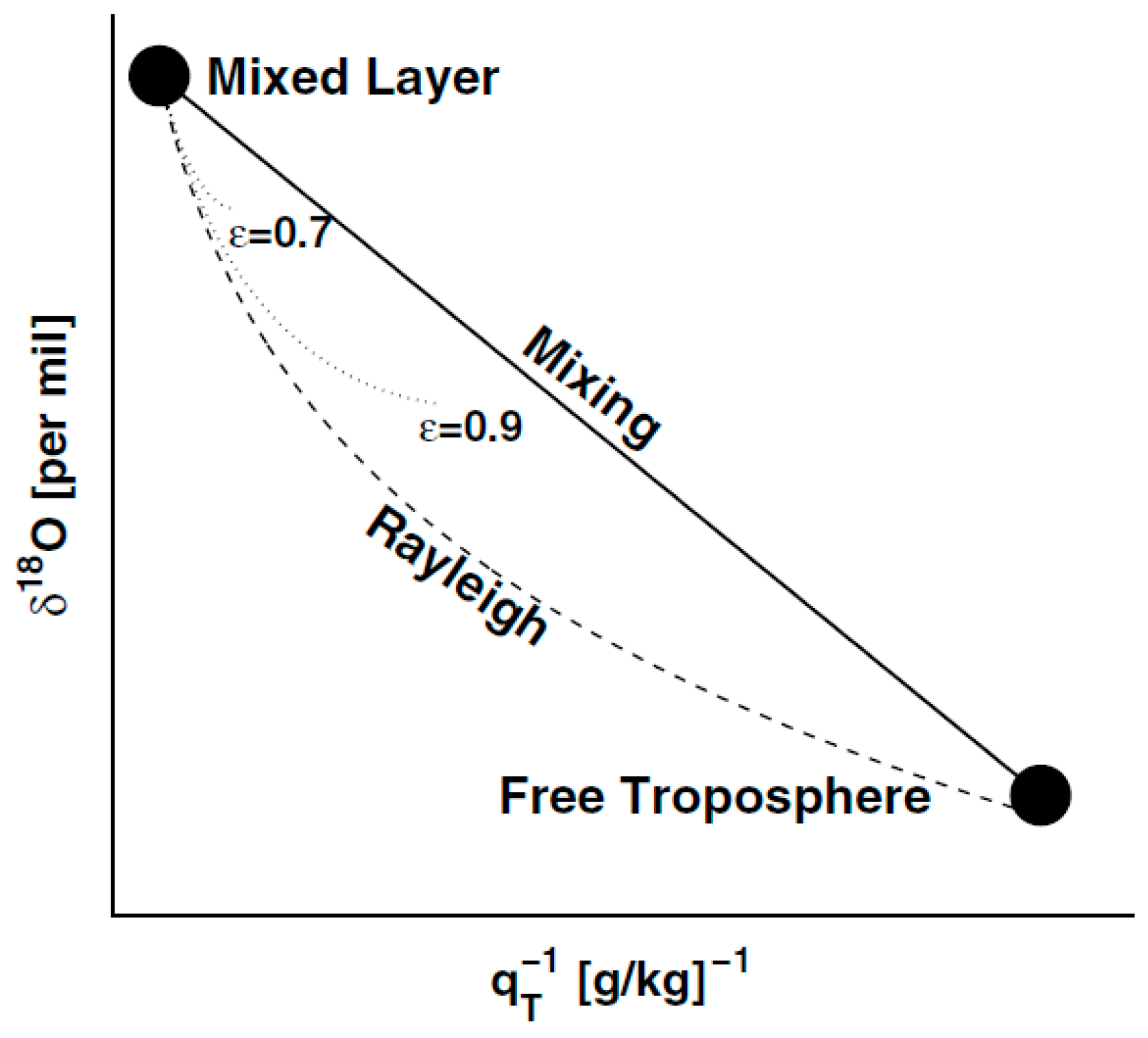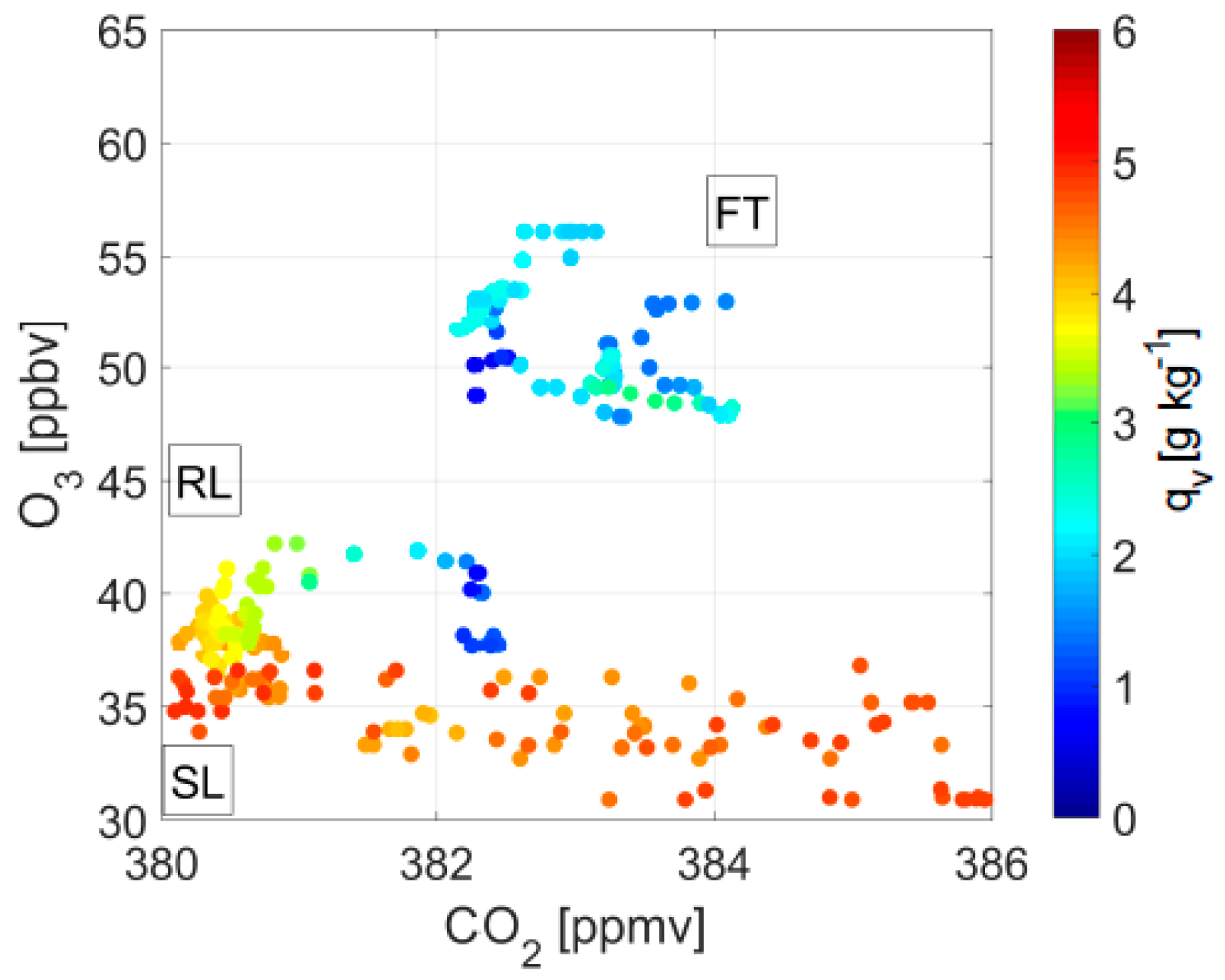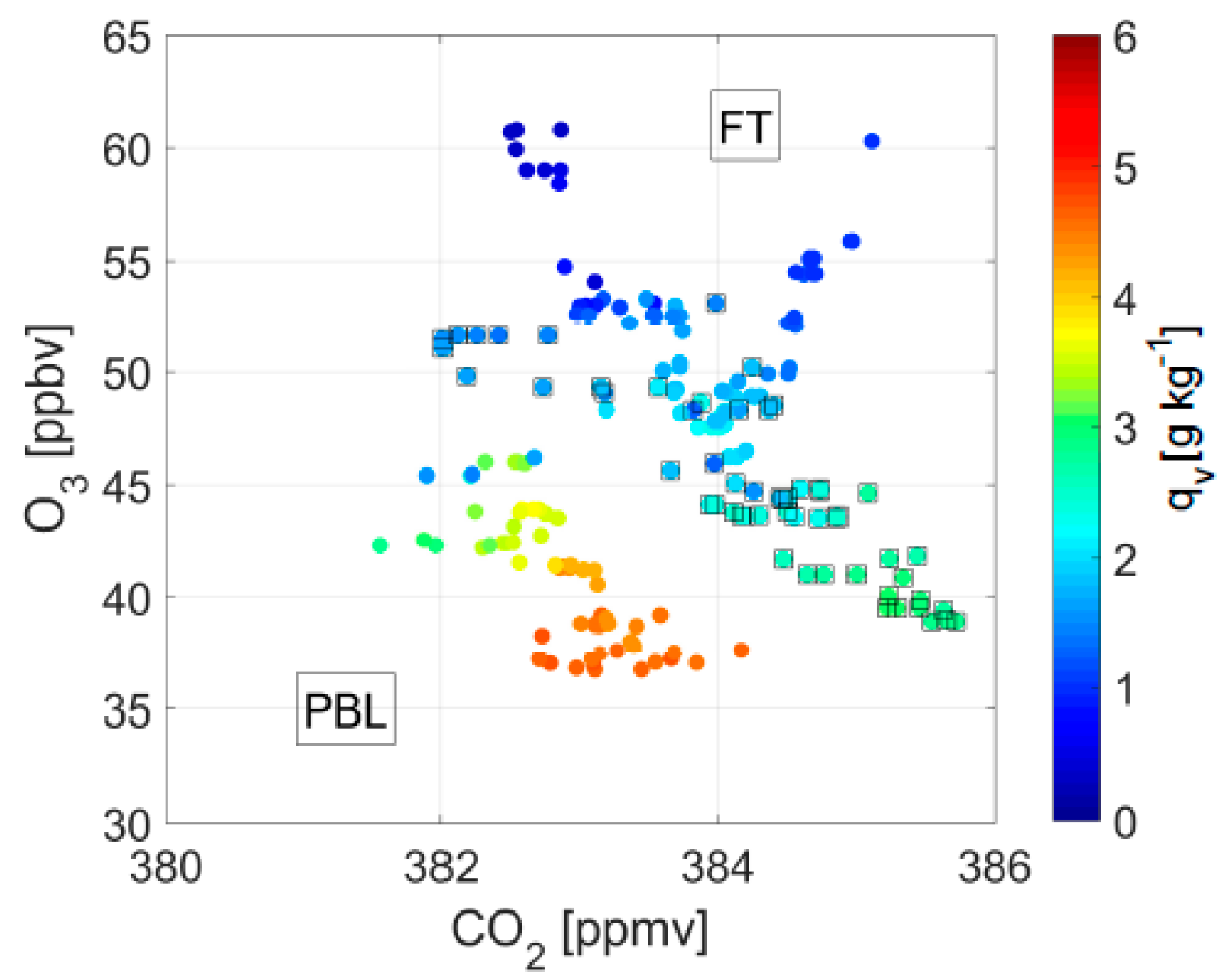A Review on the Methods for Observing the Substance and Energy Exchange between Atmosphere Boundary Layer and Free Troposphere
Abstract
1. Introduction
2. Quantitative Measurement
2.1. Method by Investigating the Height of Inversion Layer
2.2. Method of Flux-Jump
2.3. Estimating with Dataset from the ASTEX Lagrangian Experiments
2.3.1. ECMWF Synoptic-scale Analyses of Vertical Motion, Coupled with the Observed Rate of Change of Inversion Height Following the MBL Air Column
2.3.2. Calculation of Entrainment Drying as a Residual in the Water Budget of the MBL Air Column
2.4. Method of Using Satellite Observations and Microwave Imager
2.5. Mass Budget Method
3. Qualitative Measurement
3.1. Method Based on Rayleigh Distillation and Mixing Processes
3.2. Method of Ground-Based Remote Sensing
3.3. Airborne Tracer-Tracer Relationship/Ratio Method
4. Conclusions
Author Contributions
Funding
Acknowledgments
Conflicts of Interest
References
- Stull, R.B. An Introduction to Boundary Layer Meteorology; Springer International Publishing: Dordrecht, The Netherland, 1988; pp. 1–26. [Google Scholar]
- Martin, S.; Beyrich, F.; Bange, J. Observing entrainment processes using a small unmanned aerial vehicle: A feasibility study. Bound. Layer Meteorol. 2014, 150, 449–467. [Google Scholar] [CrossRef]
- Kritz, M.A. Use of long lived radon daughters as indicators of exchange between the free troposphere and the marine boundary-layer. J. Geophys. Res. Oceans 1983, 88, 8569–8573. [Google Scholar] [CrossRef]
- Dacre, H.F.; Gray, S.L.; Belcher, S.E. A case study of boundary layer ventilation by convection and coastal processes. J. Geophys. Res. Atmos. 2007, 112. [Google Scholar] [CrossRef]
- Driedonks, A.G.M.; Tennekes, H. Entrainment effects in the well-mixed atmospheric boundary-layer. Bound. Layer Meteorol. 1984, 30, 75–105. [Google Scholar] [CrossRef]
- Neiburger, M.; Chen, W.C.; Johson, D.S. Studies of the structure of the atmosphere over the eastern pacific ocean in summer. 1, inversion over the eastern north Pacific Ocean. Phys. Rev. B 1961, 61, 4033–4040. [Google Scholar]
- Albrecht, B.A. Model of the thermodynamic structure of the trade-wind boundary-layer: 2. Applications. J. Atmos. Sci. 1979, 36, 90–98. [Google Scholar] [CrossRef]
- Stevens, B.; Lenschow, D.H.; Vali, G.; Gerber, H.; Bandy, A.; Blomquist, B.; Brenguier, J.L.; Bretherton, C.S.; Burnet, F.; Campos, T.; et al. Dynamics and chemistry of marine stratocumulus-dycoms-II. B. Am. Meteorol. Soc. 2003, 84, 579–593. [Google Scholar] [CrossRef]
- Augstein, E.; Schmidt, H.; Ostapoff, F. The vertical structure of the atmospheric planetary boundary layer in undisturbed trade winds over the atlantic ocean. Bound. Layer Meteorol. 1974, 6, 129–150. [Google Scholar] [CrossRef]
- Helliker, B.R.; Berry, J.A.; Betts, A.K.; Bakwin, P.S.; Davis, K.J.; Denning, A.S.; Ehleringer, J.R.; Miller, J.B.; Butler, M.P.; Ricciuto, D.M. Estimates of net CO2 flux by application of equilibrium boundary layer concepts to CO2 and water vapor measurements from a tall tower. J. Geophys. Res. Atmos. 2004, 109. [Google Scholar] [CrossRef]
- Lai, C.T.; Schauer, A.J.; Owensby, C.; Ham, J.M.; Helliker, B.; Tans, P.P.; Ehleringer, J.R. Regional CO2 fluxes inferred from mixing ratio measurements: Estimates from flask air samples in central kansas, USA. Tellus. B 2006, 58, 523–536. [Google Scholar] [CrossRef]
- Desai, A.R.; Helliker, B.R.; Moorcroft, P.R.; Andrews, A.E.; Berry, J.A. Climatic controls of interannual variability in regional carbon fluxes from top-down and bottom-up perspectives. J. Geophys. Res. Biogeosci. 2010, 115, 02011–02115. [Google Scholar] [CrossRef]
- Dang, X.; Lai, C.-T.; Hollinger, D.Y.; Schauer, A.J.; Xiao, J.; Munger, J.W.; Owensby, C.; Ehleringer, J.R. Combining tower mixing ratio and community model data to estimate regional-scale net ecosystem carbon exchange by boundary layer inversion over four flux towers in the united states. J. Geophys. Res. Biogeosci. 2011, 116, 113–120. [Google Scholar] [CrossRef]
- Denmead, O.T.; Raupach, M.R.; Dunin, F.X.; Cleugh, H.A.; Leuning, R. Boundary layer budgets for regional estimates of scalar fluxes. Glob. Chang. Biol. 1996, 2, 255–264. [Google Scholar] [CrossRef]
- Levy, P.E.; Grelle, A.; Lindroth, A.; Molder, M.; Jarvis, P.G.; Kruijt, B.; Moncrieff, J.B. Regional-scale CO2 fluxes over central sweden by a boundary layer budget method. Agric. Forest Meteorol. 1999, 98, 169–180. [Google Scholar] [CrossRef]
- Kuck, L.R.; Smith, T.; Balsley, B.B.; Helmig, D.; Conway, T.J.; Tans, P.P.; Davis, K.; Jensen, M.L.; Bognar, J.A.; Arrieta, R.V.; et al. Measurements of landscape-scale fluxes of carbon dioxide in the peruvian amazon by vertical profiling through the atmospheric boundary layer. J. Geophys. Res. Atmos. 2000, 105, 22137–22146. [Google Scholar] [CrossRef]
- Lloyd, J.; Francey, R.J.; Mollicone, D.; Raupach, M.R.; Sogachev, A.; Arneth, A.; Byers, J.N.; Kelliher, F.M.; Rebmann, C.; Valentini, R.; et al. Vertical profiles, boundary layer budgets and regional flux estimates for CO2 and its C-13/C-12 ratio and for water vapor above a forest/bog mosaic in central siberia. Glob. Biogeochem. Cycles 2001, 15, 267–284. [Google Scholar] [CrossRef]
- Styles, J.M.; Lloyd, J.; Zolotoukhine, D.; Lawton, K.A.; Tchebakova, N.; Francey, R.J.; Arneth, A.; Salamakho, D.; Kolle, O.; Schulze, E.D. Estimates of regional surface carbon dioxide exchange and carbon and oxygen isotope discrimination during photosynthesis from concentration profiles in the atmospheric boundary layer. Tellus. B 2002, 54, 768–783. [Google Scholar] [CrossRef]
- Lilly, D.K. Models of cloud-topped mixed layers under a strong inversion. Q. J. R. Meteorol. Soc. 1968, 94, 292–309. [Google Scholar] [CrossRef]
- Kawa, S.R.; Pearson, R. An observational study of stratocumulus entrainment and thermodynamics. J. Atmos. Sci. 1989, 46, 2649–2661. [Google Scholar] [CrossRef]
- Bretherton, C.S.; Pincus, R. Cloudiness and marine boundary-layer dynamics in the astex lagrangian experiments: 1. Synoptic setting and vertical structure. J. Atmos. Sci. 1995, 52, 2707–2723. [Google Scholar] [CrossRef]
- Bretherton, C.S.; Austin, P.; Siems, S.T. Cloudiness and marine boundary-layer dynamics in the astex lagrangian experiments.2. Cloudiness, drizzle, surface fluxes and entrainment. J. Atmos. Sci. 1995, 52, 2724–2735. [Google Scholar] [CrossRef]
- Lenschow, D.H.; Pearson, R.; Stankov, B.B. Measurements of ozone vertical flux to ocean and forest. J. Geophys. Res. C. Oceans Atmos. 1982, 87, 8833–8837. [Google Scholar] [CrossRef]
- Stevens, B.; Lenschow, D.H.; Faloona, I.; Moeng, C.H.; Lilly, D.K.; Blomquist, B.; Vali, G.; Bandy, A.; Campos, T.; Gerber, H.; et al. On entrainment rates in nocturnal marine stratocumulus. Q. J. R. Meteorol. Soc. 2003, 129, 3469–3493. [Google Scholar] [CrossRef]
- Faloona, I.; Lenschow, D.H.; Campos, T.; Stevens, B.; Van-Zanten, M.; Blomquist, B.; Thornton, D.; Bandy, A.; Gerber, H. Observations of entrainment in eastern pacific marine stratocumulus using three conserved scalars. J. Atmos. Sci. 2005, 62, 3268–3285. [Google Scholar] [CrossRef]
- Wood, R.; Bretherton, C.S. Boundary layer depth, entrainment and decoupling in the cloud-capped subtropical and tropical marine boundary layer. J. Clim. 2004, 17, 3576–3588. [Google Scholar] [CrossRef]
- Kritz, M.A.; Rancher, J. Circulation of Na, Cl and Br in the tropical marine atmosphere. J. Geophys. Res. Oceans 1980, 85, 1633–1639. [Google Scholar] [CrossRef]
- Kritz, M.A. Exchange of sulfur between the free troposphere, marine boundary-layer and the sea-surface. J. Geophys. Res. C Oceans Atmos. 1982, 87, 8795–8803. [Google Scholar] [CrossRef]
- Moore, H.E.; Poet, S.E.; Martell, E.A.; Wilkening, M.H. Origin of Rn-222 and its long-lived daughters in air over hawaii. J. Geophys. Res. 1974, 79, 5019–5024. [Google Scholar] [CrossRef]
- Libby, W.F. Radioactive fallout and radioactive strontium. Science 1956, 123, 657–660. [Google Scholar] [CrossRef] [PubMed]
- Gordon, C.M.; Jones, E.C.; Larson, R.E. Vertical distribution of particulate Na and Cl in a marine atmosphere. J. Geophys. Res. C Oceans Atmos. 1977, 82, 988–990. [Google Scholar] [CrossRef]
- Turekian, K.K.; Kharkar, D.P.; Thomson, J. The fates of Pb-210 and Po-210 in the ocean surface. J. Rech. Atmos. 1974, 8, 639–646. [Google Scholar]
- Henne, S.; Furger, M.; Nyeki, S.; Steinbacher, M.; Neininger, B.; de Wekker, S.F.J.; Dommen, J.; Spichtinger, N.; Stohl, A.; Prevot, A.S.H. Quantification of topographic venting of boundary layer air to the free troposphere. Atmos. Chem. Phys. 2004, 4, 497–509. [Google Scholar] [CrossRef]
- Bailey, A.; Toohey, D.; Noone, D. Characterizing moisture exchange between the hawaiian convective boundary layer and free troposphere using stable isotopes in water. J. Geophys. Res. Atmos. 2013, 118, 8208–8221. [Google Scholar] [CrossRef]
- Schmidt, M.; Maseyk, K.; Lett, C.; Biron, P.; Richard, P.; Bariac, T.; Seibt, U. Concentration effects on laser-based del O-18 and del H-2 measurements and implications for the calibration of vapour measurements with liquid standards. Rapid Commun. Mass. Sp. 2010, 24, 3553–3561. [Google Scholar] [CrossRef] [PubMed]
- Aemisegger, F.; Sturm, P.; Graf, P.; Sodemann, H.; Pfahl, S.; Knohl, A.; Wernli, H. Measuring variations of delta o-18 and delta h-2 in atmospheric water vapour using two commercial laser-based spectrometers: An instrument characterisation study. Atmos. Meas. Tech. 2012, 5, 1491–1511. [Google Scholar] [CrossRef]
- Bigeleisen, J. Statistical mechanics of isotope effects on thermodynamic properties of condensed systems. J. Chem. Phys. 1961, 34, 1485–1493. [Google Scholar] [CrossRef]
- Dansgaard, W. Stable isotopes in precipitation. Tellus 1964, 16, 436–468. [Google Scholar] [CrossRef]
- Gat, J.R. Oxygen and hydrogen isotopes in the hydrologic cycle. Annu. Rev. Earth. Pl. Sci. 1996, 24, 225–262. [Google Scholar] [CrossRef]
- He, H.; Smith, R.B. Stable isotope composition of water vapor in the atmospheric boundary layer above the forests of new England. J. Geophys. Res. Atmos. 1999, 104, 11657–11673. [Google Scholar] [CrossRef]
- Noone, D.; Galewsky, J.; Sharp, Z.D.; Worden, J.; Barnes, J.; Baer, D.; Bailey, A.; Brown, D.P.; Christensen, L.; Crosson, E.; et al. Properties of air mass mixing and humidity in the subtropics from measurements of the D/H isotope ratio of water vapor at the Mauna Loa Observatory. J. Geophys. Res. Atmos. 2011, 116, 898–908. [Google Scholar] [CrossRef]
- Worden, J.; Noone, D.; Bowman, K.; Tropospheric-Emission, S. Importance of rain evaporation and continental convection in the tropical water cycle. Nature 2007, 445, 528–532. [Google Scholar] [CrossRef] [PubMed]
- Noone, D. Pairing measurements of the water vapor isotope ratio with humidity to deduce atmospheric moistening and dehydration in the tropical midtroposphere. J. Clim. 2012, 25, 4476–4494. [Google Scholar] [CrossRef]
- Gonzalez, Y.; Schneider, M.; Dyroff, C.; Rodriguez, S.; Christner, E.; Elena Garcia, O.; Cuevas, E.; Jose Bustos, J.; Ramos, R.; Guirado-Fuentes, C.; et al. Detecting moisture transport pathways to the subtropical north Atlantic free troposphere using paired H2O-delta D in situ measurements. Atmos. Chem. Phys. 2016, 16, 4251–4269. [Google Scholar] [CrossRef]
- Takahashi, A.; Hiyama, T.; Nishikawa, M.; Fujinami, H.; Higuchi, A.; Li, W.; Liu, W.; Fukushima, Y. Diurnal variation of water vapor mixing between the atmospheric boundary layer and free atmosphere over Changwu, the loess plateau in China. Sola 2008, 4, 33–36. [Google Scholar] [CrossRef]
- Turner, D.D.; Wulfmeyer, V.; Berg, L.K.; Schween, J.H. Water vapor turbulence profiles in stationary continental convective mixed layers. J. Geophys. Res. Atmos. 2014, 119, 11151–11165. [Google Scholar] [CrossRef]
- Berkes, F.; Hoor, P.; Bozem, H.; Kunkel, D.; Sprenger, M.; Henne, S. Airborne observation of mixing across the entrainment zone during parade 2011. Atmos. Chem. Phys. 2016, 16, 6011–6025. [Google Scholar] [CrossRef]
- Vogelezang, D.H.P.; Holtslag, A.A.M. Evaluation and model impacts of alternative boundary-layer height formulations. Bound. Layer Meteorol. 1996, 81, 245–269. [Google Scholar] [CrossRef]
- Seibert, P.; Beyrich, F.; Gryning, S.E.; Joffre, S.; Rasmussen, A.; Tercier, P. Review and intercomparison of operational methods for the determination of the mixing height. Atmos. Environ. 2000, 34, 1001–1027. [Google Scholar] [CrossRef]
- Schneider, J.; Eixmann, R. Three years of routine Raman lidar measurements of tropospheric aerosols: Backscattering, extinction and residual layer height. Atmos. Chem. Phys. 2002, 2, 313–323. [Google Scholar] [CrossRef]
- Stevens, B. On the growth of layers of nonprecipitating cumulus convection. J. Atmos. Sci. 2007, 64, 2916–2931. [Google Scholar] [CrossRef]
- Malinowski, S.P.; Haman, K.E.; Kopec, M.K.; Kumala, W.; Gerber, H. Small-scale turbulent mixing at stratocumulus top observed by means of high resolution airborne temperature and lwc measurements. J. Phys. Conf. Ser. 2011, 318, 072013. [Google Scholar] [CrossRef]
- Parrish, D.D.; Trainer, M.; Holloway, J.S.; Yee, J.E.; Warshawsky, M.S.; Fehsenfeld, F.C.; Forbes, G.L.; Moody, J.L. Relationships between ozone and carbon monoxide at surface sites in the north atlantic region. J. Geophys. Res. Atmos. 1998, 103, 13357–13376. [Google Scholar] [CrossRef]
- Trainer, M.; Parrish, D.D.; Buhr, M.P.; Norton, R.B.; Fehsenfeld, F.C.; Anlauf, K.G.; Bottenheim, J.W.; Tang, Y.Z.; Wiebe, H.A.; Roberts, J.M.; et al. Correlation of ozone with NOy in photochemically aged air. J. Geophys. Res. Atmos. 1993, 98, 2917–2925. [Google Scholar] [CrossRef]
- Neuman, J.A.; Trainer, M.; Aikin, K.C.; Angevine, W.M.; Brioude, J.; Brown, S.S.; de Gouw, J.A.; Dube, W.P.; Flynn, J.H.; Graus, M.; et al. Observations of ozone transport from the free troposphere to the Los Angeles basin. J. Geophys. Res. Atmos. 2012, 117, 214–221. [Google Scholar] [CrossRef]
- Jia, S.; Xu, X.; Lin, W.; Wang, Y.; He, X.; Zhang, H. Increased mixing ratio of surface ozone by nighttime convection process over the north china plain. J. Appl. Meteor. Sci. 2015, 26, 280–290. [Google Scholar]
- Weiss-Penzias, P.; Jaffe, D.A.; Swartzendruber, P.; Dennison, J.B.; Chand, D.; Hafner, W.; Prestbo, E. Observations of Asian air pollution in the free troposphere at mount bachelor observatory during the spring of 2004. J. Geophys. Res. Atmos. 2006, 111, D10304. [Google Scholar] [CrossRef]



© 2018 by the authors. Licensee MDPI, Basel, Switzerland. This article is an open access article distributed under the terms and conditions of the Creative Commons Attribution (CC BY) license (http://creativecommons.org/licenses/by/4.0/).
Share and Cite
Zhang, H.; Zhou, X.; Zou, J.; Wang, W.; Xue, L.; Ding, Q.; Wang, X.; Zhang, N.; Ding, A.; Sun, J.; et al. A Review on the Methods for Observing the Substance and Energy Exchange between Atmosphere Boundary Layer and Free Troposphere. Atmosphere 2018, 9, 460. https://doi.org/10.3390/atmos9120460
Zhang H, Zhou X, Zou J, Wang W, Xue L, Ding Q, Wang X, Zhang N, Ding A, Sun J, et al. A Review on the Methods for Observing the Substance and Energy Exchange between Atmosphere Boundary Layer and Free Troposphere. Atmosphere. 2018; 9(12):460. https://doi.org/10.3390/atmos9120460
Chicago/Turabian StyleZhang, Haozhe, Xuehua Zhou, Jun Zou, Wuke Wang, Likun Xue, Qiuji Ding, Xinfeng Wang, Ning Zhang, Aijun Ding, Jianning Sun, and et al. 2018. "A Review on the Methods for Observing the Substance and Energy Exchange between Atmosphere Boundary Layer and Free Troposphere" Atmosphere 9, no. 12: 460. https://doi.org/10.3390/atmos9120460
APA StyleZhang, H., Zhou, X., Zou, J., Wang, W., Xue, L., Ding, Q., Wang, X., Zhang, N., Ding, A., Sun, J., & Wang, W. (2018). A Review on the Methods for Observing the Substance and Energy Exchange between Atmosphere Boundary Layer and Free Troposphere. Atmosphere, 9(12), 460. https://doi.org/10.3390/atmos9120460




